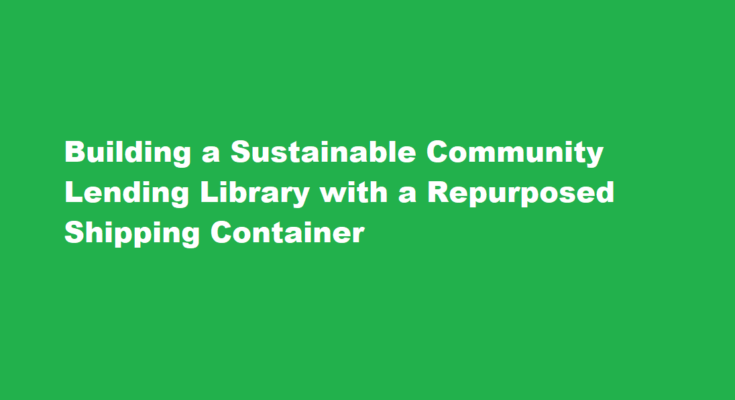Introduction
In an era of heightened environmental consciousness and a growing focus on community-driven initiatives, constructing a lending library using a repurposed shipping container is a fantastic way to blend sustainability, creativity, and community engagement. These mini-libraries offer free access to books and resources, fostering a sense of togetherness and intellectual growth. In this article, we will explore a step-by-step guide on how to construct your own community lending library from a repurposed shipping container, highlighting the benefits, considerations, and tips for success.
Choosing the Right Container
The first step in creating a lending library is selecting a suitable shipping container. Look for containers in good condition with minimal rust and structural damage. Standard-sized shipping containers (usually 20 or 40 feet long) are readily available, making them a practical choice. Considerations should include adequate space for shelving, sufficient lighting, and proper ventilation. Additionally, ensure the container’s location complies with local zoning laws and allows community access.
Designing the Layout
Designing an efficient and inviting layout is crucial for the library’s success. Prioritize open spaces for bookshelves, reading areas, and circulation paths. Use natural light as much as possible to create a warm and inviting atmosphere. Install windows and transparent doors to enhance visibility and encourage passersby to explore the library’s offerings. Emphasize functionality by incorporating benches, tables, and even a small play area for children to encourage longer stays and community interaction.
Insulation and Climate Control
To maintain a comfortable environment for visitors and protect the books, proper insulation and climate control are essential. Insulate the container using eco-friendly materials like recycled denim or rigid foam. Consider adding a small HVAC system to control temperature and humidity, ensuring books remain in good condition regardless of weather conditions.
Book Donations and Organization
To stock the lending library, encourage book donations from community members. Establish a system for organizing and categorizing the books to facilitate easy access for borrowers. Use bookshelves, bins, or even custom-made racks to keep books orderly and visually appealing. Incorporate signage and labels to make it simple for users to locate their desired genres and authors.
Engaging the Community
A successful community lending library depends on active community involvement. Organize events like book clubs, storytelling sessions, or author meet-and-greets to foster a sense of belonging and encourage more individuals to use the library regularly. Collaborate with local schools, organizations, and businesses to promote the library and its services. Utilize social media and local advertising to spread the word about the library and its events.
Maintenance and Sustainability
Regular maintenance is crucial to keep the library functioning smoothly. Establish a volunteer system to check on the library regularly, ensuring it remains clean and well-maintained. Encourage users to treat the space with respect and report any issues promptly. Emphasize sustainability by using energy-efficient lighting, promoting recycling, and offering e-books as an option.
FREQUENTLY ASKED QUESTIONS
What is the cheapest way to insulate a shipping container?
Using Styrofoam as the insulating material doesn’t require any build-out of stud walls to secure the panels (as batt insulation does). The panels are glued directly onto the walls of the shipping container or mounted on bars that are flush with the walls, making it the most economical insulation method.
Are shipping containers heat proof?
The answer is yes, shipping containers such as the ones Gateway sell can be used for fire protection. They are made of fireproof materials and can withstand high temperatures.
Conclusion
Constructing a community lending library from a repurposed shipping container offers an excellent opportunity to create a sustainable and community-oriented space. By following these steps and involving the community, this project can enrich lives, promote literacy, and serve as a beacon of unity for years to come.
Read Also : Crafting a Customized Daily Routine Unleashing Productivity and Fostering Creativity



